How you pack and organize your backpack for hiking or travel directly impacts your experience. This is true of all forms of photography, but perhaps especially night photography. After all, you will need to access your belongings repeatedly in the dark.
Probably like you, the way you pack will change over time. But here’s how I do it for my night photography trips. Even if you don’t do night photography, you might find much of this useful as general organizing and packing tips.
The camera backpack I use for hiking and traveling when photographing at night
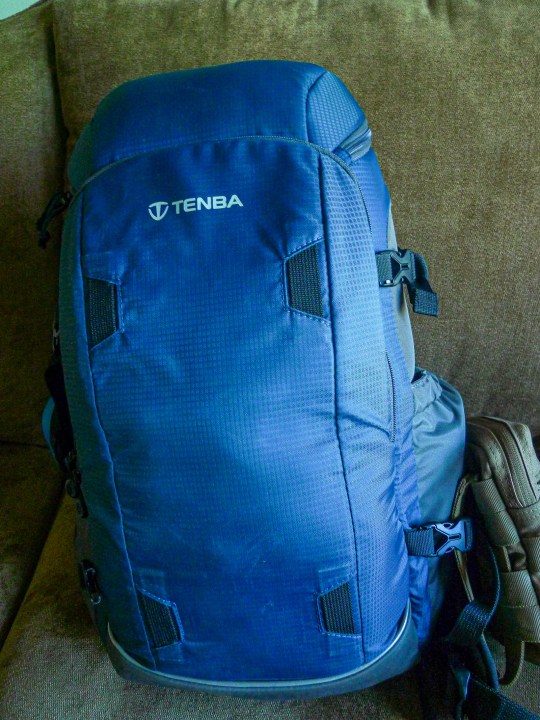
There’s no such thing as a perfect camera bag, of course. But so far, I’m loving this Tenba Solstice 20L backpack. It’s comfortable even despite the weight, has sufficient padding to protect the gear well, and is logically laid out.
It stands up easily on its own, as the bag, like many Tenba bags, holds its own shape due to the padding. It’s also water-resistant and even has a waterproof bag inside the top compartment, should you need to use it. As a bonus, it doesn’t scream “I am a camera bag” to others, although it does look like an extra nice backpack, something the average person might not use for muddy socks and underwear.
It also has deep side pockets for drinks or other gear. I can easily fit two 32-ounce drink bottles on my backpack, one in each side pocket. I usually keep drinks in the side pouches because if there’s a leak, it won’t leak into my gear.
Back access to the camera bag
.mgl-tiles { display: none; } #mgl-gallery-634eb70636724 { margin: -5px; width: calc(100% + 10px); } #mgl-gallery-634eb70636724 .mgl-box { padding: 5px; } @media screen and (max-width: 768px) { #mgl-gallery-634eb70636724 { margin: -5px; width: calc(100% + 10px); } #mgl-gallery-634eb70636724 .mgl-box { padding: 5px; } } @media screen and (max-width: 460px) { #mgl-gallery-634eb70636724 { margin: -5px; width: calc(100% + 10px); } #mgl-gallery-634eb70636724 .mgl-box { padding: 5px; } }
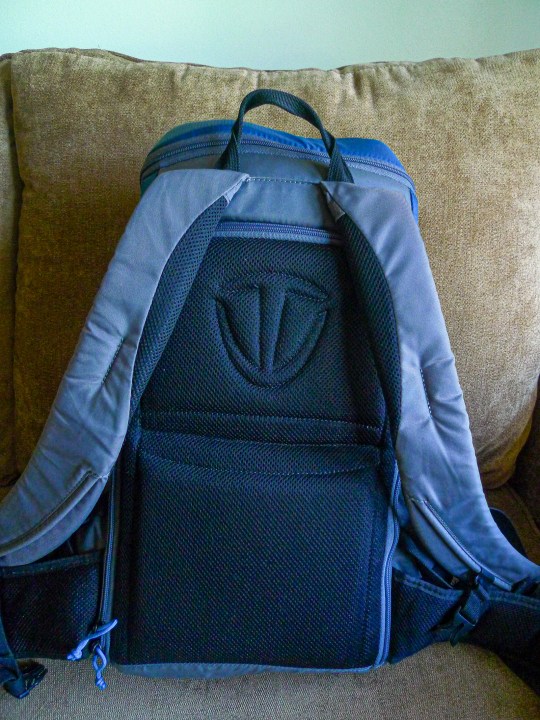
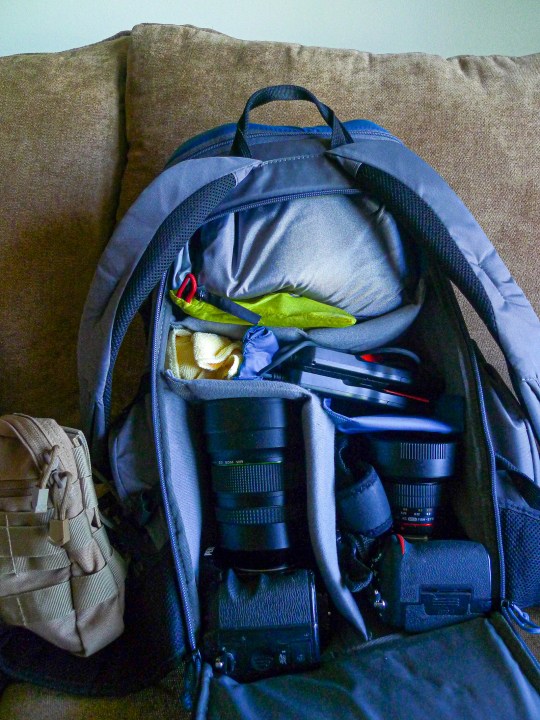
I prefer to have a camera backpack that opens from the rear. If it is muddy, I can access all my gear without taking off the backpack. If my waist strap is on, I simply take off the shoulder straps and turn the backpack around so it is facing me and then access everything from the back without having to take the backpack off and put it on muddy ground.
With the back open, you can see that I have two cameras. On the left is a Pentax K-1 with an attached Pentax 15-30mm f/2.8 lens. On the right is a Nikon D750 with a Rokinon 12mm f/2.8 lens.
Above the cameras is a large microfiber cloth, and to the right of that, two Vello Shutterboss II intervalometers. One is for the Pentax since its connector differs from Nikon connectors. To differentiate, I labeled it with orange tape that says “Kentax” (see what I did there?).
Above the cloth and intervalometers is a small yellow emergency first aid kit. And above that is a Think Tank pouch with chargers and random things.
What goes on the top compartment?
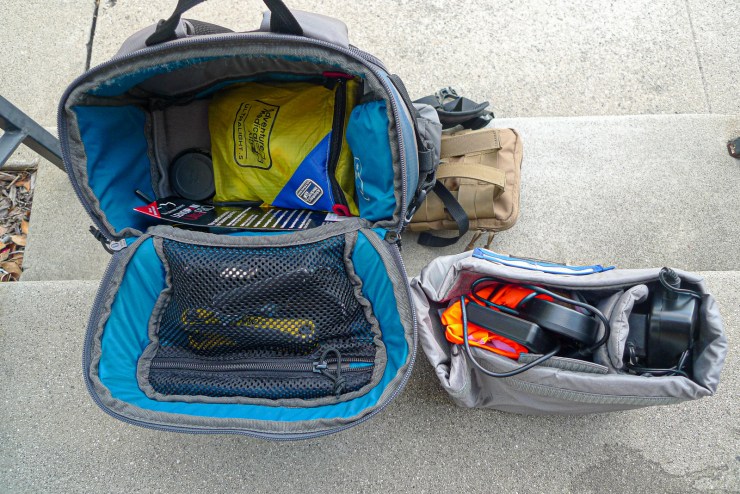
This is a view of the bag looking down. I have removed the gray Think Tank bag for this photo. The idea of the Think Tank bag is that I keep all my belongings that I ordinarily don’t need out in the field, such as battery chargers, USB cables and various other accessories. I leave these in the car or in the motel room.
After I remove the gray Think Tank bag from the camera backpack, I have lots of room. Right now, I have the yellow first aid kit, a Nikon body cap and an extra LensPen. I love lots of room for snacks, an extra shirt, a jacket and a beanie.
Sometimes I put a roll of orange gaffer’s tape inside as well. Gaffer’s tape makes everything right. You can tape down the focus ring of your lens, tape cables to keep them out of the way, keep a broken battery door from flapping open or a thousand other uses. It’s the secret weapon in your night photography bag, the tool that makes everything alright.
Inside the zipped pouch, you can see a yellow Allen wrench, a spare remote shutter cable release and a small microfiber cloth.
Exterior pouch to keep things easily accessible
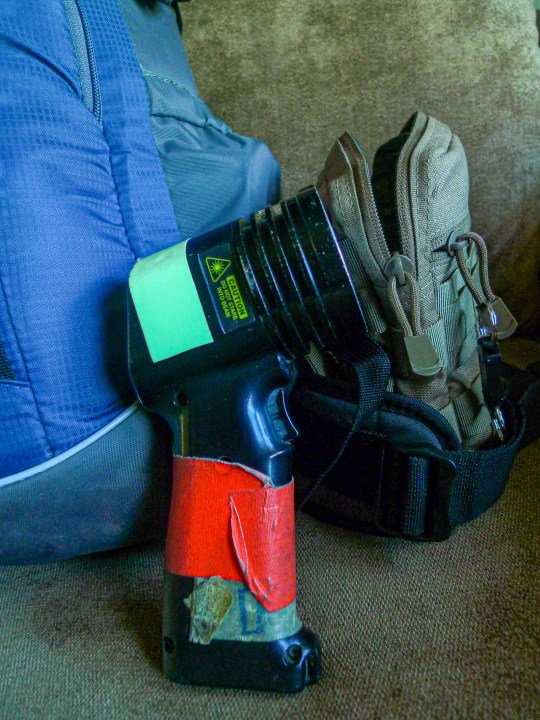
I like to keep my light painting equipment easily accessible. I use a pouch outside the bag that I purchased at an Army/Navy surplus store for the ProtoMachines LED2 light painting device that I use for almost every night photography outing.
I also have pepper spray inside this pouch. I’ve never had to use pepper spray, and hope I never will. I sometimes remove the holster from the backpack and wear it on my belt if I am not going to have the entire backpack with me for evening easier access.
What is all the tape for?
The white tape is a glow-in-the-dark tape, while the orange tape is just some horrible-looking gaffer’s tape that I should remove but have not. This is the light painting device of a working night photographer. It ain’t pretty, but it’s functional and harder to lose in the dark.
Storing small things conveniently in the front compartments
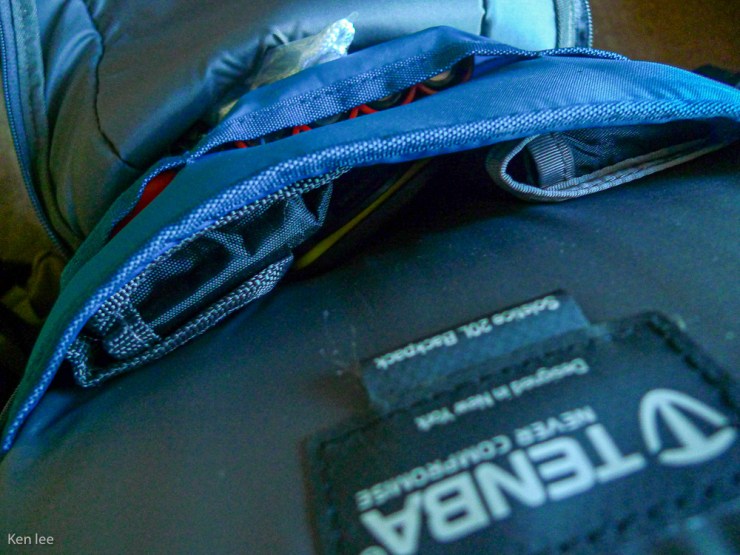
Finally, a view of the front compartment of the Tenba bag. Here, I keep a plastic cover for the camera if it begins sprinkling or if I am doing photos near a waterfall or the ocean. Saltwater and electronics do not mix. You can see the white string of this bag peaking out on top.
Lots of batteries
Below that, you can just barely see some orange battery holders. I use these for storing extra batteries. Easy access. And in the innermost pocket at the bottom of the photo, you can see several black battery organizers for camera batteries.
I like having lots of extra batteries because you never know how many batteries you are going to plow through on a cold night. Better safe than sorry. I prefer these battery organizers because it keeps everything neat and accessible, but also because the contacts of the batteries never meet.
Also inside is an SD card holder, which you can barely see … you can see the thin yellow stripe.
Where does the tripod go?
When I am doing night photography, I usually carry a 26″ Feisol carbon fiber tripod. If I wanted to, I could attach this tripod to the side pocket and strap it in or use straps and strap it to the front of the backpack. However, in practice, I don’t do this unless I am hiking relatively far.
If there is one weakness of the Tenba Solstice 20L, it’s that it is not the best backpack I’ve had for attaching large tripods. Then again, many people don’t have a tripod larger than 26 inches collapsed. Regardless, I can carry all the equipment you see here and still be able to slide it underneath the seat of an airplane. I’ll live with the trade-off.
Finding your way in the dark
I keep everything in a specific place and can find everything even when it is completely dark outside. I can still access my belongings without turning on my headlamp and blowing out my eyes when it’s dark.
I hope this gives you some ideas. How do you pack for night photography? What would you do? Feel free to start a conversation below in the comments section. Thanks for reading.
Tell your story with the second annual Visual Storytelling Conference!
Experience four days of interactive, online training sessions featuring a range of educational content with experienced photographers and content creators. This free event kicks off with a series of technical boot camps to build essential skills, followed by live, online sessions on photography, video, business and social media. Join live from March 10-13, 2022!
